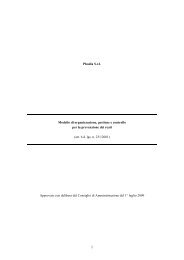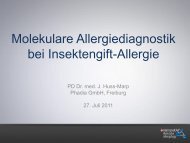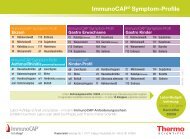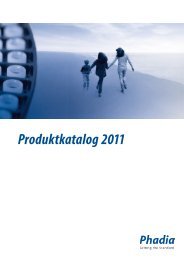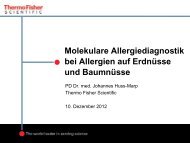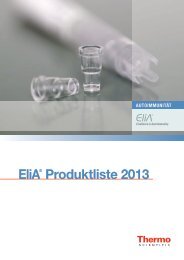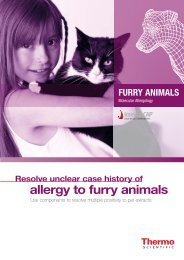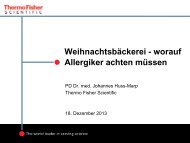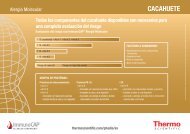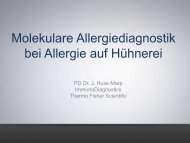DIRECTIONS FOR USE CONTENTS INTENDED USE ... - Phadia
DIRECTIONS FOR USE CONTENTS INTENDED USE ... - Phadia
DIRECTIONS FOR USE CONTENTS INTENDED USE ... - Phadia
You also want an ePaper? Increase the reach of your titles
YUMPU automatically turns print PDFs into web optimized ePapers that Google loves.
<strong>Phadia</strong> 250Sm FLUOROENZYMEIMMUNOASSAY <strong>FOR</strong> ANTI Sm ANTIBODIES<strong>FOR</strong> IN VITRO DIAGNOSTIC <strong>USE</strong><strong>DIRECTIONS</strong> <strong>FOR</strong> <strong>USE</strong><strong>CONTENTS</strong>EliA uses a modular reagent system. All information needed to understand the useof the EliA tests can be found in the analyte specific DfU and the correspondingEliA Control DfU.<strong>INTENDED</strong> <strong>USE</strong>EliA Sm is intended for the in vitro quantitative measurement of IgG antibodies directedto Sm in human serum and plasma as an aid in the clinical diagnosis of systemic lupuserythematosus (SLE). EliA Sm uses the EliA IgG method on the instrument <strong>Phadia</strong> 250.SUMMARY AND EXPLANATION OF THE TESTThe determination of antinuclear antibodies (ANA) is of central importance for the clinicaldiagnosis of connective tissue diseases. Sm antibodies offer a highly specific, but comparativelyinsensitive, clinical marker for SLE. Indeed, their presence constitutes one ofthe revised ACR criteria for diagnosis, even though their overall prevalence ranges from20 % to 30 % in SLE. 3,4PRINCIPLES OF THE PROCEDUREThe EliA Sm Wells are coated with native Sm proteins purified from bovine tissue. Ifpresent in the patient's specimen, antibodies to Sm bind to their specific antigen. Afterwashing away non-bound antibodies, enzyme-labeled antibodies against human IgGantibodies (EliA IgG Conjugate) are added to form an antibody-conjugate complex. Afterincubation, non-bound conjugate is washed away and the bound complex is incubatedwith a Development Solution. After stopping the reaction, the fluorescence in the reactionmixture is measured. The higher the response value, the more specific IgG is presentin the specimen. To evaluate test results, the response for patient samples is compareddirectly to the response for calibratorsREAGENTS / MATERIALNot for use in the USAThe EliA reagents are available as modular packages, each purchased separately. Allpackages except for the EliA ANA Positive Control 250 and the EliA IgG/IgM/IgA NegativeControl 250 are required to carry out an EliA Sm Test.The EliA Sm Wells are packed in carriers which are stored in sealed aluminium foil bagscontaining a desiccant.EliA Sm Test-Specific ReagentsEliA Sm Well (Art. No. 14-5502-01)Sm Well;short name: smcoated with nativeSm proteins purifiedfrom bovine tissue4 carriers (12 wellseach); sufficient for48 determinationsEliA ANA Positive Control 250 (Art. No 83-1033-01)Human serum inPBS containing BSA,detergent and sodiumazide (0.095 %);symbol: posMultiparametercontrol containingIgG antibodies todsDNA, RNP, Sm,Ro, La, Scl-70, CENPand Jo-16 single-use vials(0.3 ml each);sufficient for 2 determinationsper vialEliA ANA Positive Control 250 is prepared from selected pooled human sera.EliA IgG/IgM/IgA Negative Control 250 (Art. No 83-1037-01)Human serum inPBS containing BSA,detergent and sodiumazide (0.095 %);symbol: negMultiparameter controlcontaining normalsera from healthydonors6 single-use vials(0.3 ml each);sufficient for 2 determinationsper vialEliA IgG/IgM/IgA Negative Control 250 is prepared from selected pooled human sera.EliA Method-Specific Reagents (<strong>Phadia</strong> 250)EliA Sample Diluent (Art. No 83-1023-01)Sample Diluent (yellow 6 bottles (48 ml each);colored); PBS containing sufficient for ≥ 6 x 180 dilutionsBSA, detergent and sodiumazide (0.095 %)EliA IgG Conjugate 50 (Art. No 83-1017-01)IgG Conjugate (blue colored); 6 wedge shaped bottlesß-Galactosidase anti-IgG (5 ml each); sufficient(mouse monoclonal antibodies)in PBS containingfor 6 x 50 determinationsBSA and sodium azide(0.06 %); symbol: El-GEliA IgG Conjugate 200 (Art. No 83-1018-01)IgG Conjugate (blue colored); 6 wedge shaped bottlesß-Galactosidase anti-IgG (19 ml each); sufficient(mouse monoclonal antibodies)in PBS containingfor 6 x 200 determinationsBSA and sodium azide(0.06 %); symbol: El-GEliA IgG Calibrator Strips (Art. No 83-1015-01)human IgG (0, 4, 10, 20, 100, 5 strips600 μg/l); in PBS containing 6 single-use vials per stripBSA, detergent and sodium (0.3 ml each); sufficient forazide (0.095 %)one calibration curve(double determination)ready for use; storedry at 2-8 °C untilexpiration dateReady for use; storeat 2-8 °C until expirationdateready for use; storeat 2-8 °C until expirationdateready for use; store at 2-8 °Cuntil expiration dateready for use; store at 2-8 °Cuntil expiration dateDO NOT FREEZEDO NOT RE<strong>USE</strong>ready for use; store at 2-8 °Cuntil expiration dateDO NOT FREEZEDO NOT RE<strong>USE</strong>ready for use; store at 2-8 °Cuntil expiration dateManufactured from human sera.250-5502-08 / UK 1/4SmPublished 2011-Nov-10 Page 1(4)
EliA IgG Curve Control Strips (Art. No 83-1016-01)human IgG (20 μg/l); in PBS 5 stripscontaining BSA, detergent Each strip contains 6 x 0.3 mland sodium azide (0.095 %) CC-1 (double determination)symbol: CC-1Manufactured from human sera.EliA IgG Calibrator Well (Art. No 14-5509-01)IgG Calibrator Well coated 4 carriers (12 wells each); sufficientfor 48 determinationswith mouse monoclonal antibodies;short name: Gcal<strong>Phadia</strong> 250 General ReagentsDevelopment Solution (Art. No. 10-9440-01)Development Solution 0.01 % 6 bottles (17 ml each);4-Methylumbelliferyl-β-D-galactoside,170 determinationsStop Solution (Art. No. 10-9442-01)Stop Solution 4 % Sodium 6 bottles (119 ml each);Carbonatesufficient for 6 x >560 determinationsDilution Plates (Art. No. 12-3907-08)MicroWell plates with 60 plates per package;96 wells, 0.5 ml each;sufficient for 60 x 96 samplesPolypropyleneready for use; store at 2-8 °Cuntil expiration dateready for use; store dry at2-8 °C until expiration dateready for use; store at 2-8 °Cuntil expiration dateDO NOT FREEZEready for use; store at 2-8 °Cuntil expiration dateready for useDO NOT RE<strong>USE</strong>* Preservative: mixture of 5-chloro-2-methyl-2H-isothiazol-3-one [EC no. 247-500-7] and 2-methyl-2H-isothiazol-3-one[EC no. 220-239-6] (3:1).Washing Solution (Art. No. 10-9422-01/10-9202-01)For information see separate Washing Solution package insert.WARNINGS AND PRECAUTIONS• For in vitro diagnostic use.• Do not use reagents beyond their expiration dates.• We do not recommend to pool reagents.• Wear gloves while handling samples and reagents provided.• Some of the reagents are manufactured from human blood components. The sourcematerials have been tested by immunoassay for hepatitis B surface antigen, for antibodiesto HIV1, HIV2 and hepatitis C virus and found negative. Nevertheless, all recommendedprecautions for the handling of blood derivatives should be observed. Pleaserefer to Human Health Service (HHS) Publication No. (CDC) 93-8395 or local and nationalguidelines on laboratory safety procedures.WARNING! Reagents contain sodium azide (NaN 3 ) as a preservative. NaN 3 maybe toxic if ingested or absorbed by skin or eyes. NaN 3 may react with lead andcopper plumbing to form highly explosive metal azides. On disposal, flush witha large volume of water to prevent azide build-up. Please refer to decontaminationprocedures as outlined by CDC or other local and national guidelines.Waste Bottle and ImmunoCAP/EliA Well Waste Container may be contaminated bypotentially infectious material. Use appropriate safety measures and wear gloves.Indication of Instability<strong>Phadia</strong> 250 Instrument Software has built-in acceptance limits for the calibration curveand the curve control. EliA Wells are moisture sensitive. An activity loss that mightoccur due to inappropriate handling can be detected using the appropriate EliA Control.For more information see <strong>Phadia</strong> 250 User's Guide/Reference Manual.INSTRUMENTEliA reagents are to be used with the <strong>Phadia</strong> 250 Instrument Software version 1.05 orhigher. The <strong>Phadia</strong> 250 Instrument processes all steps of the test. For further informationregarding test set-up, instrumentation and software etc. see <strong>Phadia</strong> 250 User's Guide/Reference Manual.SPECIMEN COLLECTION, HANDLING AND PREPARATIONThe procedure can be performed with serum or plasma specimens. Lipemic, hemolyzedor microbially contaminated samples may give poor results and should not be used. Avoidrepeated freezing and thawing. Samples should be stored in aliquots at -20 °C (-4 °F) orbelow for repeated measurements.Sample DilutionSamples must be diluted with EliA Sample Diluent. A 1:100 dilution of the samples isrequired for the EliA Sm Test. Samples can be diluted manually, but instrument dilution isrecommended.PROCEDUREHandling of EliA Sm WellIn the <strong>Phadia</strong> 250 storage chamber, carriers are stable for up to 28 days. If you are notexpecting to use them up within this time, the carriers should be loaded via the <strong>Phadia</strong> 250Loading Tray and, for stability reasons, must be put back into the desiccant-containingfoil bag directly after the run. Because it is important to store the wells in dry conditions at2-8°C, the bag must be properly resealed. If stored under these conditions, the shelf-lifefrom the date of first opening is 9 months, if not limited by the expiry date stated on thecarrier and foil bag.Lot specific barcodeUse the built-in barcode reader to enter the lot specific information of EliA Sm Well, EliAIgG Calibrator Well and EliA IgG Conjugate. In case of manual handling make sure toenter the characters below the barcode.On-board stability of reagents• EliA WellsEliA Well carriers can be stored on-board for 28 days at 2-8°C or 24 hours at roomtemperature.• EliA Calibrator Strips, EliA Curve Control StripsCan be stored on-board for 28 days. During longer interval between usage (>3 days)it is recommended to unload the strips from the instrument and store them at 2-8°C.• EliA Sample DiluentCan be stored on-board for 7 days at room temperature. Re-cap bottles every night.250-5502-08 / UK 2/4SmPublished 2011-Nov-10 Page 2(4)
• EliA ConjugateCan be stored on-board at 2-8°C until expiry date. Single use reagent, open vials mustnot be stored.• Development Solution, Stop SolutionCan be stored on-board for a total of 40h at room temperature. Can be used 5 timesduring shelf life and be stored at room temperature for 8 hours on each occasion. Recapbottles every night. During weekends or longer interval between instrument usageit is recommended to store bottles at 2-8°C.• Wash SolutionPrepared solution can be stored on-board for 7 days at room temperature. During1 week the same bottle can be refilled. Discard what’s left after last run on Friday andstart with freshly prepared Wash Solution in cleaned bottle on Monday.Volumes per determinationReagent volumes per determinationCalibrator90 μlEliA IgG Conjugate90 μlDevelopment Solution 90 μlStop Solution200 μlSample volumes per determinationManual dilution:90 μl of diluted sampleInstrument dilution (1:100): 20 μl of non diluted sampleFor tube-specific dead volumes see <strong>Phadia</strong> 250 User's Guide/Reference Manual.Reagent volumes per 200 determinationsWashing Solution 5-7 l*Rinse Solution 5-6 l** The residual volume depends on the number of samples and dilution method used.Procedural comments• From one sample diluted by the instrument (1:100), up to 11 determinations can bemade.• When using software default, samples are run in single determination.• Washing Solution must be at room temperature when used.• The first result is available after approx. 2 hours and further results at one minute intervalsafterwards. Up to 5 x 10 samples can be loaded continuously and are processedby random access.• Incubations are automatically performed at 37 °C (98.6 °F).• If you want to perform more than one test per patient you can also use the followingpredefined test panels:Name DescriptionEliA tests includedpana Connective tissue disease dsDNA, U1RNP, RNP70, Sm, Ro, La, Scl-70, CENP, Jo-1pena ENA U1RNP, RNP70, Sm, Ro, La, Scl-70, CENP, Jo-1psle Systemic lupus erythematosus dsDNA, Sm, Ro, Lapspe Speckled pattern U1RNP, Sm, Ro, LaCALIBRATION AND REFERENCE MATERIALThe calibration curve is obtained with EliA IgG Calibrators which are run in duplicate. Thecurve is stored and subsequent tests are evaluated against the stored curve using onlythe EliA IgG Curve Control (run in duplicate).The IgG Calibrators are traceable via an unbroken chain of calibrations to the InternationalReference Preparation (IRP) 67/86 of Human Serum Immunoglobulins A, G and M fromWorld Health Organization (WHO).A new calibration curve must be run when:• the last calibration was made more than one month ago or• a new lot of EliA IgG Conjugate is introduced or• when the EliA IgG Curve Control is outside the specified limits (defined in<strong>Phadia</strong> 250 Instrument Software).There are no international standards for Sm antibodies. Results are given in arbitraryEliA Units/ml.QUALITY CONTROLControl SpecimensGood laboratory practice requires that quality control specimens should be included inevery run. Any material used should be assayed repeatedly to establish mean values andacceptance ranges.EliA Controls are available for the quality control of the measurements.CALCULATION AND INTERPRETATION OF RESULTSPresentation of Results<strong>Phadia</strong> 250 measures specific IgG concentrations in μg/l. By using a conversion factorgiven by the lot-specific code of the EliA Sm Well, the results are automatically convertedto EliA U/ml.Interpretation of Test ResultsThe ranges (negative, equivocal, positive) recommended for the evaluation of the resultsare given in the table below.Test Unit negative equivocal positiveEliA Sm EliA U/ml < 5 5 - 10 > 10Good laboratory practice requires that each laboratory establishes its own range of expectedvalues.LIMITATIONSA definitive clinical diagnosis should not be based on the results of a single diagnosticmethod, but should only be made by the physician after all clinical and laboratory findingshave been evaluated.EXPECTED VALUESAntibody prevalence in autoimmune patients varies widely depending on disease area.The proportion of sera from a normal population found positive for Sm antibodies coveredby the EliA Sm test is below 1 %. Expected values may vary depending on the populationtested. 1,2,3,4,5250-5502-08 / UK 3/4SmPublished 2011-Nov-10 Page 3(4)
Results Obtained for Healthy SubjectsThe frequency distribution for Sm antibodies was investigated on the instrument <strong>Phadia</strong>100 in a group of apparently healthy subjects equally distributed by age and gender, usingsera from a Caucasian population obtained from a blood bank. The results are given inthe table below. (1)Test Unit No.of Mean 95%- 99%-Samples Value percentile percentileEliA Sm EliA U/ml 400 0.3 0.5 1.1A comparison study between <strong>Phadia</strong> 100 and <strong>Phadia</strong> 250 was performed at <strong>Phadia</strong> AB,Uppsala, Sweden, with 36 patient samples to assess the analytical performance of bothsystems. Results show good agreement.PER<strong>FOR</strong>MANCE CHARACTERISTICSMeasuring RangeThe measuring range (detection limit, upper limit) for EliA Sm is from 0.1 to ≥ 120 EliAU/ml. No hook effects could be observed for concentrations up to 10 fold above themeasuring ranges. (1)Only values above the Detection Limit can be regarded as valid results. The upper limitof the reported results can vary due to a lot-specific conversion from μg/l to EliA U/ml.Results above the upper limit are reported as “above”.Please note that due to differing binding characteristics of the antibodies in patient samples,not all sera can be diluted linearly within the measuring range.SpecificityThe EliA Sm Test permits the determination of IgG antibodies directed against the Smantigen as described in section “Reagents”.PrecisionTo determine the precision of the assay, the variability was assessed in studies with 21runs by examining 3 samples on 3 instruments. The statistical evaluation was performedby Analysis of Variance. The results are given in the table below. (2)Test Sample Unit Mean Coefficients of variation (%)Value Intra-Run Inter-Run1 EliA U/ml 8.3 5.2 5.2EliA Sm 2 EliA U/ml 24.8 4.9 4.23 EliA U/ml 47.8 5.7 3.9WARRANTYThe performance data presented here was obtained using the procedure indicated. Anychange or modification in the procedure not recommended by <strong>Phadia</strong> AB may affect theresults, in which event <strong>Phadia</strong> AB disclaims all warranties expressed, implied or statutory,including the implied warranty of merchantability and fitness for use.<strong>Phadia</strong> AB and its authorized distributors, in such event, shall not be liable for damages,indirect or consequential.REFERENCES1. Tan EM, Cohen AS, Fries JF, et al. (1982) The 1982 revised criteria for the classification of systemic lupus erythematosus.Arthritis Rheum 25, 1271-12772. Smeenk RJT, Berden JHM, Swaak AJG (1996) dsDNA Autoantibodies. In: Peter JB, Shoenfeld Y (eds),Autoantibodies, pp 227-236, Elsevier, Amsterdam3. Peng SL, Craft JE (1996) Spliceosomal snRNPs autoantibodies. In: Peter JB, Shoenfeld Y (eds),Autoantibodies, pp 774-782, Elsevier, Amsterdam4. Tan EM (1999) Autoantibodies in Diagnosis and in Identifying Autoantigens. Immunologist 7, 85-925. van den Hoogen FHJ, van de Putte LBA (1996) Anti-U1snRNP antibodies and clinical associations.In: van Venrooij WJ, Maini RN (eds), Manual of Biological Markers of Disease, pp C3.1, 1-8, Kluwer AcademicPublishers, DordrechßLOTß Batch codeÄ Biological RiskStore at 2-8°C/35-46°F'( Expiration dateßIVDß For in vitro diagnostic use)¿ Contains sodium azideÀContains x determinations§ Read Directions for Use&Manufactured by" Do not reuse in a second run& <strong>Phadia</strong> ABSE-75 137 Uppsala, SwedenPhone: +46-18-16 50 60 · Fax: +46-18-14 03 58E-mail: autoimmunity@phadia.com / Internet: www.phadia.comIssued October 2011© <strong>Phadia</strong> GmbH, Freiburg, Germany(1) Studies performed at <strong>Phadia</strong> GmbH, Freiburg, Germany(2) Studies performed at <strong>Phadia</strong> AB, Uppsala, Sweden250-5502-08 / UK 4/4SmPublished 2011-Nov-10 Page 4(4)




